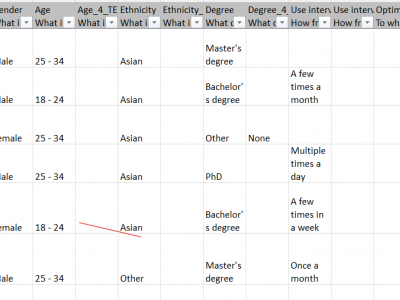*.csv
The poor posture is one of the main common health problems in the growth of adolescents, which seriously affects their physical and mental health. The posture gait recognition is a premise for preventing and correcting the poor posture. This paper proposes a gait recognition method for poor posture based on PCA-BP neural network. Using wearable intelligent insoles to measure plantar pressure, a gait recognition model based on PCA-BP neural network model is constructed.
- Categories:
 536 Views
536 Views
The VNA dataset has three features: frequency, S21, and phase, while the MIMO dataset has an additional 'Channel' feature. The VNA dataset is larger than the MIMO dataset, with 507,709 rows compared to 164,161 rows in the MIMO dataset. This is because the VNA dataset was sampled at a 1 MHz resolution, while the MIMO dataset was sampled at a 25 MHz resolution, which is the limit set by the MATLAB API. As a result, the VNA dataset provides 4,701 samples per tag, while the MIMO dataset provides 190 samples per tag per channel for each reading.
- Categories:
 129 Views
129 Views
This dataset is collected to benchmark different software algorithms for UWB indoor localization. The dataset is collected in a controlled environment with mm-accurate groundtruth to evaluate different algorithms. The data is collected with the Wi-Pos UWB system,a platform developed for research data collection with a wireless long-range Sub-GHz backbone combined with UWB ranging based on the DW1000. The UWB is configured with a center frequency of 6489.6 MHz, a bandwidth of 499.2 MHz (channel 5) and a preamble length of 1024 symbols.
- Categories:
 314 Views
314 Views
The first Algerian forest fires dataset consist of data on forest fires occurrence in Algeria related to meteorological observations and the fire weather indices. Our dataset includes mainly the daily meteorological observations and the Fire Weather Index (FWI) system components. Given the lack of publically available datasets on data on forest fires occurrence in Algeria we have created this one to study the feasibility of the appliance of machine learning algorithms as models for forest fires prediction in the context of Algeria.
- Categories:
 1137 Views
1137 Views
Normal
0
21
false
false
false
CS
X-NONE
X-NONE
- Categories:
 74 Views
74 Views
We collected relevant data of ultrasonic Doppler flowmeter in the laboratory to study the error of ultrasonic Doppler flowmeter. It contains four sets of data at different turbidities and four sets of data at different liquid levels. Each set of data under different turbidities contains 440 pieces of data, and each set of experiments under different liquid levels contains 220 pieces of data. The entire data set has a total of 2720 pieces of data. The training set test split is 8:2, which we have already split in the uploaded data set.
- Categories:
 83 Views
83 ViewsThis paper presents a bi-directional Long ShortTerm Memory (LSTM) model for the detection of landslides. Previous uses of machine learning in this setting have demonstrated its general potential, which necessitates the implementation of a suitable algorithm. Landslides are natural disasters that can cause significant destruction and disruption in the affected areas. Early detection is the key to minimizing the impact of landslides, so it is important to develop accurate and efficient models.
- Categories:
 1931 Views
1931 Views
The dataset consists of measurements of four different stages of degradation in low-voltage contactors used for industrial purposes. The measurements were obtained with fiber Bragg grating (FBG) sensors that detect the dynamic deformation generated in switching under different internal components. The measurements were processed and features from PSD, FFT and TSFEL python library were extracted. The features of PSD and FFT were acquired in 40 sliding windows of 50Hz from the signal.
- Categories:
 155 Views
155 Views


